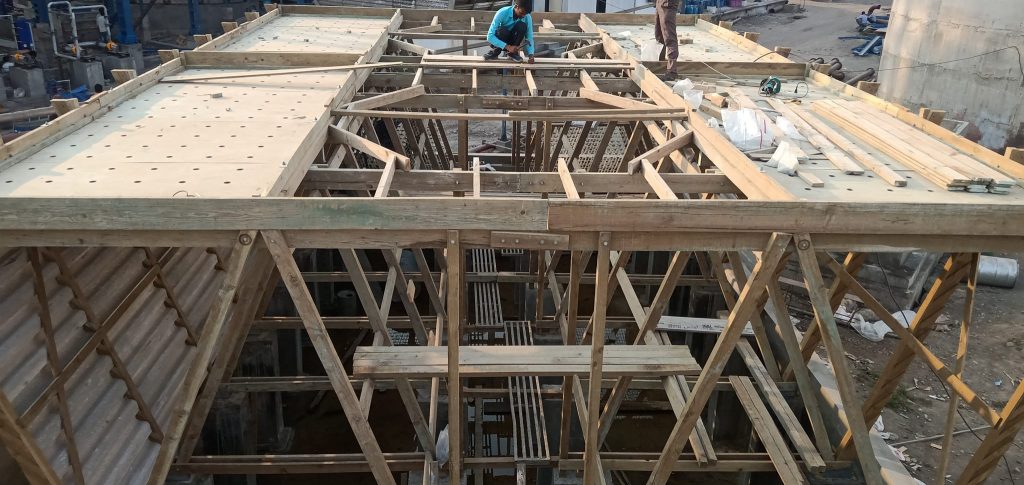The working principle of a wooden cooling tower is based on evaporative cooling, where hot water is cooled by direct contact with air, resulting in partial evaporation. Here’s a step-by-step breakdown of how it operates:
1. Hot Water Inlet
- Industrial process water (heated by machinery, power plants, or HVAC systems) enters the tower through inlet pipes at the top.
- Temperature range: Typically 40–60°C (104–140°F).
2. Water Distribution System
- The hot water is evenly distributed over the fill media (wooden slats or plastic packs) via:
- Gravity-fed spray nozzles (in Cross flow towers).
- Pressurized spray systems (in Counter flow towers).
3. Fill Media (Wooden Slats or Modern Alternatives)
- The fill material (traditionally wooden splash bars or modern PVC fills) breaks up the water flow, increasing the surface area for better heat exchange.
- Function: Slows water flow, maximizing air-water contact for efficient cooling.
4. Airflow Generation (Natural or Mechanical Draft)
- Natural Draft (Hyperbolic Towers):
- Uses chimney effect—hot air rises, pulling in cool air from the bottom (common in large power plants).
- Mechanical Draft (Forced or Induced):
- Forced Draft: Blower fans push air into the tower.
- Induced Draft: Fans at the top pull air upwards (more common in wooden towers).
5. Evaporative Cooling Process
- As air passes over the water:
- Heat transfer occurs: Water releases heat to the air.
- Evaporation (~1-3% of water) removes latent heat, cooling the remaining water.
- Cooled water collects in the basin at the bottom (now 5–10°C cooler).
6. Cool Water Return & Reuse
- The chilled water is pumped back to industrial processes (e.g., condensers, reactors).
- Makeup water replenishes evaporated loss.
7. Drift Eliminators
- Prevent water droplets from escaping with the exhaust air, conserving water.
Key Components of a Wooden Cooling Tower:
| Component | Function |
| Wooden Structure | Provides corrosion-resistant support. |
| Fill Media | Increases water-air contact for cooling. |
| Fans (Mechanical Draft) | Enhances airflow for faster cooling. |
| Water Distribution System | Spreads water evenly over fill media. |
| Drift Eliminators | Reduces water loss via airborne droplets. |
| Cold Water Basin | Collects cooled water for reuse. |
Types of Wooden Cooling Towers
- Cross flow Design
- Air flows horizontally, water falls vertically.
- Lower pumping energy, easier maintenance.
- Counter flow Design
- Air flows upwards, water falls downwards.
- More efficient but requires higher fan power.
- Natural Draft (Rare for Wooden Towers)
- Used in very large installations (e.g., power plants).
Thermodynamics Behind Cooling
Key Components of a Wooden Cooling Tower:
| Component | Function |
| Wooden Structure | Provides corrosion-resistant support. |
| Fill Media | Increases water-air contact for cooling. |
| Fans (Mechanical Draft) | Enhances airflow for faster cooling. |
| Water Distribution System | Spreads water evenly over fill media. |
| Drift Eliminators | Reduces water loss via airborne droplets. |
| Cold Water Basin | Collects cooled water for reuse. |
Types of Wooden Cooling Towers
- Cross flow Design
- Air flows horizontally, water falls vertically.
- Lower pumping energy, easier maintenance.
- Counter flow Design
- Air flows upwards, water falls downwards.
- More efficient but requires higher fan power.
- Natural Draft (Rare for Wooden Towers)
- Used in very large installations (e.g., power plants).
Thermodynamics Behind Cooling
- Latent Heat of Vaporization: The primary cooling mechanism (~585 kcal/kg of evaporated water).
- Approach Temperature: Difference between cooled water temperature and wet-bulb air temperature (typically 3–5°C in efficient towers).
Advantages of Wooden Cooling Towers in Operation
Comparison with Other Cooling Towers
| Aspect | Wooden Tower | FRP Tower | Concrete Tower |
| Cooling Principle | Evaporative | Evaporative | Evaporative |
| Airflow Generation | Mechanical/Natural Draft | Mechanical Draft | Natural Draft |
| Maintenance | Moderate (wood checks) | Low | Very Low |
| Lifespan | 20–30 years | 15–25 years | 30–50 years |
